Abstract Expressionism 1933
by Gary Comenas (2009, Updated 2016)
January 1933: Jackson Pollock is taught by John Sloan.
After Thomas Hart Benton left the Art Students' League to work on a mural for the 1933 Chicago World's Fair, Jackson was taught by John Sloan in his Life Drawing, Painting, and Composition class at League. In addition to Sloan's class he also signed up for a morning class in stone-carving at Greenwich House Annex on Jones Street in January taught by Ahron Ben-Schmuel. He also worked there as a part-time custodian. He had previously taken free sculpture classes at Greenwich House on Barrow Street prior to enrolling at the Art Students' League in 1930. According to the chronology published by The Museum of Modern Art in Jackson Pollock, Jackson rendered "small sketches for murals in lunnettes at Greenwich House" in the winter of 1933, although the murals were never executed. (PP317)
Pollock quit Sloan's class after one month. In February and March he registered for night classes in clay-modelling at the Art Students' League taught by the sculptor Robert Laurent. On March 25, 1933 he wrote to his mother about sculpting "I like it better than painting - drawing tho is the essence of all." (JP62/PP317/)
Although Thomas Hart Benton returned to the Art Students League in the autumn of 1933, Jackson was no longer a student by then (see c. April 1933 below). (JP63)
January 30, 1933: Adolf Hitler is sworn in as Chancellor of the Third Reich.
1933: Modern Man in Search of a Soul by C.G. Jung is published in the United States.
The book consisted of eleven papers, six of which were included in a 1931 German language collection on "soul-problems of the present time."
1933: William Baziotes moves to New York.
1933: Philip Guston's first exhibition is held at the Stanley Rose Gallery.
The gallery was on the mezzanine of Rose's bookshop on Vine Street in Hollywood. The exhibition was organized by Herman Cherry. Rose bought a painting by Guston, Conspirators, for twenty-five dollars. Although the painting no longer exists, a photograph does. It shows an image of hooded Ku Klux Klan type figures - an image he would later return to in the late 1960s after returning to figuration. (MM17)
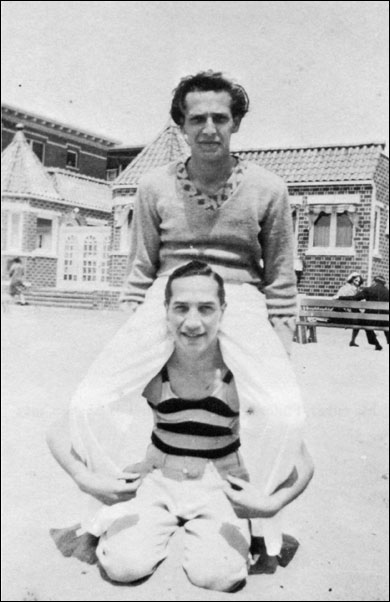
Philip Guston and his brother, Venice Beach, c. 1929
(From Musa Mayer, Night Studio: A Memoir of Philip Guston (1991))
Herman Cherry:
Philip always wore a necktie. He was nattily dressed, not like an artist. Making forty dollars a week, working for his brothers, he was considered very rich. The rest of us were all starving to death. That was always true, you know. Later, during the WPA and the forties, he made a lot of money. Phil had an early career. Made a big name for himself... always had a little of the bourgeois in him. (MM18)
February - August 1933: Barnett Newman rents a studio in Greenwich Village.
Newman's studio was at 47 Horatio Street. During the same year his family moved to a different address in the Bronx - 984 Sheridan Avenue, near the Grand Concourse. (MH)
Early 1933: Balcomb Greene returns to New York from Europe.
American artist Balcomb Greene had first gone to Europe during the 1920s to study psychology in Vienna. In 1927 he returned to New York where he taught English at Dartmouth College and wrote fiction. He and his wife Gertrude Glass returned to Europe in late 1931 where he began experimenting with painting. After he and Glass returned to New York in early 1933, he wrote articles in Art Front (the magazine of the Artists' Union which began publication in 1934) and became the editor of that magazine in 1935 and 1936, later also becoming the first chairman of the American Abstract Artists. (He also wrote for the newspapers, Broadway Brevities and Graft.) As part of the WPA he did abstract murals for the Hall of Medicine in 1939 at the New York World's Fair and the Williamsburg Housing Project and designed a stained glass window for a school in the Bronx. In approximately 1940 he began doing a master's degree in art history at New York University and from 1942 to1959 was employed by by the Carnegie Institute of Technology in Pittsburgh as an art history teacher. One of his students there was Andy Warhol. Greene and his wife commuted between Pittsburgh and New York and purchased property at Montauk Point, Long Island in 1947. His work was shown at J.B. Neumann's New Art Circle in 1947 and the Bertha Schaefer Gallery from 1950.
1933: Hans Hofmann opens his school in New York.
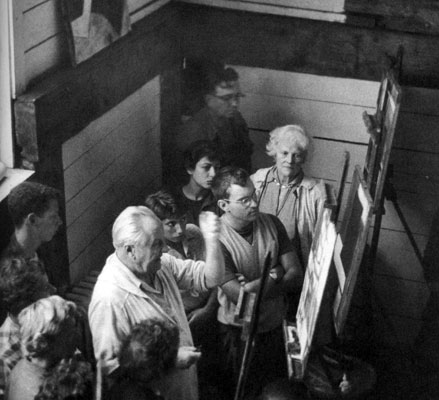
Hans Hofmann and his students at his school
(Photographer unknown)
Hofmann is more important in regard to second generation Abstract Expressionists than the first generation artists included in this chronology. None of the first generation AbEx heavyweights (such as Mark Rothko and William de Kooning) studied under him. Although Arshile Gorky never officially studied with Hofmann, he did visit his classes at the Art Students League. (BA209)
Hofmann had previously had a school in Munich which he established around 1914, and had also taught summer classes in Bavaria, France, and Italy. Artists who studied with him in Europe included Carl Holty, Glenn Wessels, Vaclav Vytlacil and Worth Ryder. At the invitation of Ryder, he traveled to the United States in the summer of 1930, teaching classes at U.C. Berkeley. He returned to Germany where he taught classes the following winter and then returned to the states in the spring to teach at the Chouinard School of Art in Los Angeles and also at Berkeley (where he wrote the first version of Creation in Form and Color: A Textbook for Instruction in Art.) He moved to New York in 1932 and taught at the Art Students League. His students there included Burgoyne Diller, Harry Holtzman and George McNeil.
February 12, 1933: Los Angeles police raid the John Reed Club.
When the police raided the Los Angeles branch of the John Reed Club, they destroyed some mural panels that had been painted by Philip Guston and Reuben Kadish.
Musa Mayer [Philip Guston's daughter]:
"The Marxist philosophy of the John Reed Club, a branch of which had newly opened in Los Angeles - which urged artists to 'abandon decisively the treacherous illusion that art can exist for art's sake' - interested my father greatly. With his friend from Otis [Art Institute], Reuben Kadish, Philip painted portable murals for the walls of the club on the plight of the American negro, specifically the famous case of the Scottsboro Boys. On one occasion, the so-called Red Squad of the L.A. Police Department broke into the club and shot out the eyes and genitals of a fresco he'd painted depicting a black man being flogged by Ku Klux Klansmen. That same year, the National Legion of Decency was formed to rid Hollywood of its leftist influences." (MM19)
From A Critical Study of Philip Guston
by Dore Ashton:
"In late 1932 Guston, Kadish, Harold Lehman, and several of their friends decided to respond to the John Reed Club's call to "abandon decisively the treacherous illusion that art can exist for art's sake." They undertook to paint "portable" murals on the theme of the American Negro, who was seen by all liberal publications of the time as the victim of lynching and other barbarous practices. Guston's mural, based directly on accounts he had read of the trial of the Scottsboro boys, showed Ku Kluxers whipping a roped black man. The murals, executed on separate panels in a shed owned by a Mexican painter, Luis Arenal, were each about 6´ 8 feet in size and were painted in fresco on increasingly fine layers of sand and cement poured into wooden frames. This undertaking was to provide the young painters with the first confirmation of their suspicions that America was in a dangerous state of violent confusion. Early one morning a band of raiders, thought to be led by the chief of the Red Squad, a man called Hines, and abetted by members of the American Legion, entered the John Reed Club brandishing lead pipes and guns. They totally destroyed several murals and, as Guston recalls with a shudder, shot out the eyes and genitals of the figures in his completed work. An eyewitness came forward to say he had seen the police enter the premises, and the artists, almost all of them in their late teens, decided to sue. At the trial the judge looked with distaste upon these insurgent Americans, declared that the murals had been destroyed by parties unknown, and suggested that it was the painters themselves who had probably done it to call attention to their cause." (DA27)
February 24, 1933: Nazis raid the German Communist Headquarters.
On February 24 an auxiliary police force organized by Göring raided the Communist headquarters, with Göring falsely claiming to have uncovered plans for a Communist uprising. What he had actually uncovered was the membership list of the German Communist party and he intended to arrest every one of the four thousand members.
February 27, 1933: A fire breaks out at the Reichstag.
On February 27, a fire broke out at the Reichstag building. The Communists were blamed although some were suspicious that the fire had been started by Hitler in order to justify his crackdown on subversives.
March 4, 1933: Franklin D. Roosevelt is inaugurated as President of the United States.
His inaugural speech included the famous quote "The only thing we have to fear is fear itself..." (JP65/RO85)
March 1933: Diego Rivera begins painting his Rockefeller Center mural.
The commission had been negotiated by Nelson Rockefeller who was the 29 year old executive head of the corporation building the Rockefeller Center. The theme of the mural as stipulated to Rivera was "Man at the Crossroads Looking with Hope and High Vision to the Choosing of a New and Better Future." (RS)
March 6, 1933: Jackson Pollock's father dies.
Jackson's father had been diagnosed with malignant endocarditis, a bacterial infection of the valves of the heart, in December 1932. (PP317) Jackson and his brothers, Charles and Frank, all living in New York, could not afford to attend the funeral in Los Angeles. (JF32)
Several months before he died Jackson's father had returned to his wife (Jackson's mother) in Los Angeles. They had been separated since October 1920. Jackson's mother described his death to her sons. She had set up a bed in the dining room so he could look out the window. She remembered that he had listened to and enjoyed Franklin D. Roosevelt's speech and not long afterward developed trouble breathing. A doctor was eventually called and while the doctor was standing in the doorway Jackson's father looked up at his wife and said 'Mother, I don't think I can last till morning.' He died in her arms.
On March 25, 1933 Jackson wrote to his mother, "I always feel I would like to have done something for he and you - many words unspoken - and now he is gone in silence... I had many things I wanted to do for you and Dad - now I'll do them for you, mother. Quit my dreaming and get them into material action." (JP65)
[Note: Deborah Soloman's biography of Jackson Pollock gives the impression that Jackson's father died on March 5, 1933, the day after Roosevelt's speech. The MoMA chronology and other sources list it as March 6, 1933.]
March 21, 1933: The formation of the Dachau concentration camp in Germany is announced.
On March 21, 1933 the Völkischer Beobachter newspaper announced "On Wednesday the first concentration camp with a capacity to hold 5,000 persons is to be erected in the vicinity of Dachau." The first prisoners were the political opponents of the Nazis including Communists, trade unionists, members of opposition political parties and Jews because of their opposition to the new regime. In the years to follow, the prisoners would also include Jehovah Witnesses and homosexuals.
c. Late March/Early April 1933: Jackson Pollock drops out of the Art Students League.
Not long after after his father's death Jackson Pollock stopped studying at the Art Students League and would never study art in a school again. Instead, he joined the ranks of the unemployed. (JP65)
April 1933: Philip Guston shows Mother and Child at the Los Angeles Museum.
Guston was one of fifty artists chosen from the three hundred who submitted works to the Fourteenth Annual Exhibition at the Los Angeles Museum. (DA29) Because the museum had excluded many of the nature painters, there was a protest by about two hundred artists who objected to the "handiworks of mediocre charlatans and fashionable faddists." The controversy was picked up by the Los Angeles Times and statements by the protestors (such as "We raise our lances to defend the sacredness of art" and "Our ideals of true Americanism are endangered") were published in the May 26th issue under the heading "Art War Breaks Out." (DA29n2)
April 1933: Jackson Pollock moves to 46 East 8th Street - and watches Diego Rivera paint Man at the Crossroads.
Jackson Pollock, his brother Charles and Charles' wife Elizabeth paid $35 a month for an entire floor of a building on East 8th Street. During April Jackson also watched Diego Rivera paint his mural in the RCA building at Rockefeller Center (PP317) A few years earlier, in 1929 when Pollock was still in California, he had expressed his admiration for Rivera in a letter to his brothers, writing (at a time when Rivera was still in Mexico) "I have thought of going to Mexico City if there is any means of making a livelihood there." (JP43)
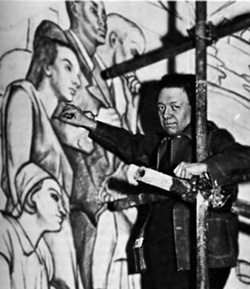
Diego Rivera painting his Rockefeller Center mural in 1933 (OA83)
April 24, 1933: Controversy erupts over Diego Rivera mural.
On April 24th, the New York World-Telegram published an article about the mural titled "Rivera Paints Scenes of Communist/Activity and John D. Jr. Foots Bill." One of the figures in the painting, which Rivera had indicated as a "worker-leader" in his verbal description of the project and only outlined roughly in his preliminary sketches now resembled Lenin in the actual mural. Nelson Rockefeller tried to persuade the painter to replace the image with someone else - perhaps just a generic person. Rivera offered to balance the Lenin portrait with one of Abraham Lincoln. Rivera hired a photographer to take pictures of the mural but the guards would not let him in. Instead one of Rivera's assistants smuggled a camera in and took photographs secretly. (RS)
Although Rivera (born Diego María de la Concepción Juan Nepomuceno Estanislao de la Rivera y Barrientos Acosta y Rodríguez in Guanajuato City, Mexico on December 8, 1886) was a Communist he had been expelled from Russia in 1928 for his involvement in anti-Soviet politics (after having arrived there in the autumn of 1927 after being invited to take part in the celebration of the 10th anniversary of the October Revolution). After his expulsion from Russia, he returned to Mexico and in 1929 was also expelled from the Communist Party of Mexico. (RS)
May 9, 1933: Diego Rivera is forced to stop work on his Rockefeller Center mural.
Rivera was ordered to leave the scaffold on May 9th. The mural was covered and Rivera was forbidden to re-enter the RCA Building which remained open to the public with the mural covered from view. The wall would be resurfaced by workers on February 9, 1934, permanently removing the mural. (RS) After John Sloan suggested that the mural's removal was censorship, the New York Times defended the its destruction in an editorial published on March 18, 1934 under the title "Mural War Persists" in their "Topics of the Times" section. (RS) A "mural" was apparently not art whereas an "easel picture" was.
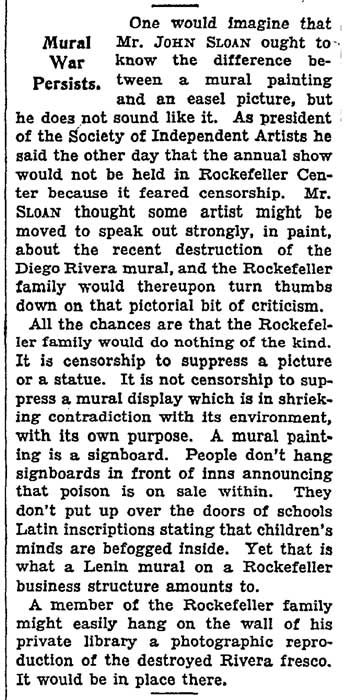
"Mural War Persists" in "Topics of the Times," New York Times, March 18, 1934
May 9, 1933: George Biddle writes to President Roosevelt to encourage state sponsored art.
Biddle was a lawyer, author, muralist, printer and Social Realist artist who came from a privileged background. One of his classmates at the prestigious Groton School where he studied as an undergraduate was Franklin D. Roosevelt, now president of the United States. In 1928 Biddle went on a sketching tour of Mexico with Diego Rivera and was impressed by the Mexican muralists. In his letter to the President, he used Mexico as an example of a country whose artists had "produced the greatest national school of mural painting since the Italian Renaissance" which was the result of allowing artists "to work at plumbers' wages in order to express on the walls of government buildings the social ideals that you are struggling to achieve." (AL) Roosevelt forwarded Biddle's letter to the Treasury Department which would in December start the Public Works of Art Project, the precursor to the WPA and the Federal Art Project. (JP79)
May 10, 1933: The Nazis burn books.
The first major 'book burning' by the Nazis took place on May 10, 1933 when about 20,000 books were burned during a public demonstration on the Opernplatz in Berlin at which Goebbels was a speaker. The books were from the Institut für Sexualwissenschaft (a sexology research institute founded in 1919 and headed by a Jewish doctor) and Humboldt University (Berlin's oldest university which both Karl Marx and Friedrich Engels had attended). The burning of books was repeated in various other cities of Germany around the same time.
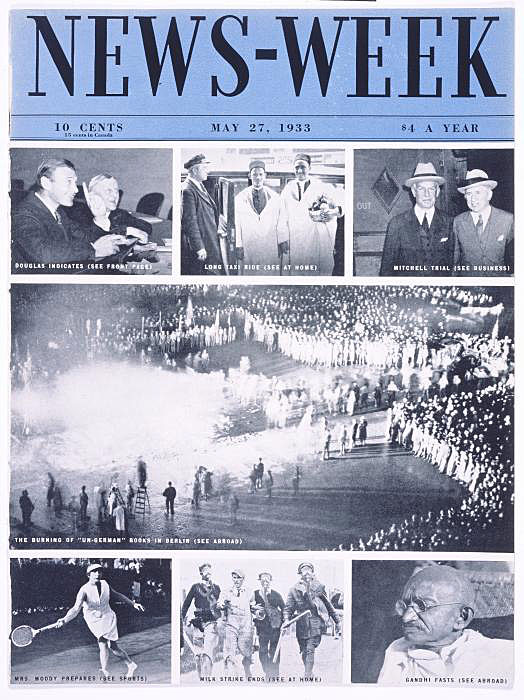
"The Burning of 'Un-German' Books in Berlin"
Front cover, News Week, May 27, 1933
1933: Clyfford Still graduates from Spokane University. (RO224)
Summer 1933: Mark Rothko exhibits in Portland, Oregon.
Mark Rothko and wife, Edith, hitchhiked cross-country, stopping at at Dufur in north-central Oregon to visit Rothko's brother Albert. Then Albert drove them to Portland where they camped in Washington Park and visited the rest of the family. Rothko painted some watercolours and gave one each to his brothers and sisters. During this visit Rothko showed his own work (and a selection of his students' work) at the Portland Art Museum which got a favorable review in the Oregonian. (RO88)
Summer 1933: Adolph Gottlieb and wife rent a place in East Gloucester.
The Gottliebs saw Milton Avery and his wife, who were also in Gloucester, "everyday". (AG16) Milton Avery's wife, Sally, also recalls that Mark Rothko and the Averys "would go away for the summer together."
Sally Avery:
"We'd take a place and then he'd [Mark Rothko] get a place near us... we went to Vermont. We went to Massachusetts, Gloucester. As a matter of fact, that's one of the places we went a few times. And we'd meet on the beach every day and go swimming and play handball and we had a lot of good, nice, wholesome times. And then in the evening they'd come over to see what Milton had...you know, Milton would show them work. And we'd have a cup of tea because that's about all we could afford... That was like in '34, '32, '33... The Gottliebs went too, yes. They'd get a place nearby... Everybody had a space to work by themselves and in the evening we'd meet together or in the afternoon we'd meet on the beach and sometimes we'd all have dinner together and whatever and then sit around and talk. I mean there was nothing....Discuss the kind of art everybody was doing. And then one summer Milton decided these boys were getting a little too dependent on him, so he decided not to show them anything. And they were very upset in the beginning but it was really very good for them because it forced them to delve into their own beings for their own ideas. At the end of the summer he showed them all his work but it wasn't this day-to-day thing that he had been doing, he had been showing them. So he'd show them things and the next morning they'd had an idea and they would us." (SW)
End Summer/Autumn 1933 - c. May 1937: Mark Rothko and wife rent 1000 Park Place.
When they returned to New York Mark Rothko and Edith rented the top floor of a three-story brownstone at 1000 Park Place, Brooklyn. While at the Park Place address (where they lived for approximately two years) they rented a room to George Okun and Morris Calden (at separate times). (RO89/579) Calden later recalled that the apartment was "cluttered; the sink was full of unwashed dishes; books, records, were lying around; clothes were too." (RO142) He also recalled that Rothko and Edith would often have "violent arguments." (RO144)
Autumn 1933: Jackson Pollock moves to 58th Street.
Jackson rented a room in the brownstone to live and work on his own. (PP317)
September 1933: Thomas Hart Benton returns to New York.
Upon their return to New York the Bentons moved into an apartment at 10 East 8th Street. The living room was lit with blue bulbs. Pollock was no longer a student at the Art Students League but would often babysit the Bentons' six year old son and clean their apartment while Benton's wife Rita was out running errands. He would tell the boy stories about a made-up hero from the wild west - Jack Sass. Thomas Hart Benton thought that Sass was the alter-ego of Jackson, later commenting that "Jack Sass was Jack Pollock without the frustrations." (JP63/67)
On Monday nights the Bentons would host a musical evening. Thomas Hart Benton had started a band, the Harmonica Rascals, after trying a toy harmonica. He decide to collect folk songs on his trips across the U.S. Benton had worked out a system of musical notation where the notes were referred to as numbers. He collected hundreds of folk songs and his Monday evenings attracted numerous musicians, including Charles Seeger, whose son Pete said that he first heard the classic folk song, John Henry, when Benton played it on his harmonica accompanied by Charles. Jackson Pollock played the Jew's harp, after unsuccessful attempts at the harmonica. According to Thomas Hart Benton, Jackson "ran into some kind of 'bloc' about reading or playing notes." (JP68) In 1934 Benton painted Pollock playing the Jew's harp for his painting The Ballad of the Jealous Love of Lone Green Valley (1934).
c. Autumn 1933: Jackson Pollock is hospitalised after a drunken brawl.
Jackson Pollock had left a party one evening and saw a wealthy looking man walking his dog on Fifth Avenue. First he got down on all fours and petted the dog and then jumped up and called the man a "son of a bitch," shouting "You feed that dog when I'm starving." A fight ensued with Jackson ending up at St. Vincent's Hospital charged by the police with battery and assault. He stayed in the hospital a few days, visited by Thomas Hart Benton's wife, Rita. The charges were later dropped. (JP67)
October 14, 1933: Germany withdraws from the League of Nations.
October 30 - December 8, 1933: "Edward Hopper: Retrospective Exhibition" at the Museum of Modern Art.
November 1933: Adolph Gottlieb and his wife move to Brooklyn.
Adolph and Esther Gottlieb moved from 14 Christopher Street in Greenwich Village to 155 State Street near Borough Hall in Brooklyn. Gottlieb befriended several other artists around this time including Louis Schanker and Louis Harris who would later join The Ten with Gottlieb (see 1935). (AG16) Gottlieb also befriended David Smith who was also living in Brooklyn and Smith's friend, the artist Stuart Davis who, like Gottlieb, had studied under Robert Henri. (AG16)
November 4, 1933: The New York World-Telegram announces Barnett Newman to run for mayor of New York.
A.J. Liebling, then a staff reporter of the newspaper, wrote "Time before the election was fleeting, but art is eternal and B. Barnett Newman, of 984 Sheridan Avenue, The Bronx, and his friend, Alexander Borodulin of 2107 E. Third Street, Brooklyn felt that the forces of self-expression should express themselves by the ballot. So Mr. Newman who is 27 and a teacher of art in a high school in Queens, decided to run for Mayor. Mr. Borodulin, also 27, a writer on aesthetics, decided to run for Comptroller." (TH13)
The article went on to say that "Just like Karl Marx, whom they cordially detest, they got out a manifesto - 'On the Need for Political Action by Men of Culture'" and quotes Newman as saying that he didn't expect to be elected "as he folded manifestos in his father's merchant tailoring establishment at 154 Nassau St. yesterday." (TH13) Liebling noted that Newman "does not have as much time as he would like for his own painting" and admires "John Sloan, Picasso, Kuniyoshi and the less-known Adolph Gottlieb and Tom Nagai above other artists." (TH13)
Barnett Newman [from the article]:
"The present political campaign in New York has now run long enough to reveal that once again the artist, the musician, the writer, the actor, the teacher, the scientist, the thinker, and the man of culture generally, have nothing to hope for from any of the candidates... Vote for Communism as a protest, and you help saddle yourself with a regime incompatible with art... We must spread culture through society. Only a society composed of artists would be really worth living in. That is our aim, which is not dictated by expediency." (TH13)
Newman and Borodulin circulated thousands of copies of a manifesto titled 'On the Need for Political Action by Men of Culture,' called for "more extensive education, a greater emphasis upon the arts and crafts, and the fostering of cultural living conditions." (MH) Other demands included the establishment of a "clean air department," a department of local waters to clean up the beaches and rivers, "low price park casinos," a local parks and playground system and "a large indoor and outdoor public forum free of police licensing." (TH14)
Although Newman did not expect to win, he hoped to rally a "body of votes" to demand "direct consideration and action" with the result that "we would not have the supreme sneer of a cheap hypocrite and politician who refused to allow artists to exhibit their created works in Washington Square because in his fat head peddling is peddling, whether it be fish or paintings, that is to say, whether it be sole or soul!" (TH14)
Also in 1933, Borodulin and Newman conceived a magazine, the New York Wednesday Answer, to promote civil service and defend the rights of public workers. Although they printed letterhead and publicity materials for the magazine, it never materialized because they were unable to attract advertisers. (MH)
November 7, 1933: Fiorello Henry La Guardia wins election for Mayor of New York.
La Guardia began the first of his three terms in office. (The number of votes received by Newman and Borodulin are unknown.) (MH)
November 20 - December 9, 1933: Mark Rothko has his first NY solo exhibition at the Contemporary Arts Gallery.
The exhibition consisted of fifteen oil paintings (mostly portraits), four watercolors (three of which were from Rothko's trip to Portland during the summer (Portland, The Oregon Forest and Mount Hood) and six works using black tempera on white paper. Rothko also showed at the gallery in their Christmas exhibitions in 1933 and 1934 and in two of their annual reviews. (RO97-98)
November 21 - December 8, 1933: Salvador Dali exhibition at the Julien Levy Gallery. (MA299)
Late 1933: Franz Kline meets Martha Kinney.
Martha Kinney (nicknamed "Nutsy") was introduced to Franz Kline by a fellow art student he had met in the autumn of 1931. Martha became his companion and model and would follow him to London in 1935. (FK176)
December 1933 - The Public Works of Art Project is founded.
The Public Works of Art Project, a short-lived (six months) predecessor to the WPA, was part of the Civil Works Administration. The goal of the Project was to create art "of the best quality available" for public buildings. (DK123)
December 20, 1933: Arshile Gorky joins the Public Works of Art Project.
To be accepted by the project Arshile Gorky submitted a sketch (30 inches by 123 inches) for a mural with a written proposal. Although the drawing has been lost, Gorky biographer, Nouritza Matossian notes that "it was a return to his first glimpse of New York and the Statue of Liberty rising out of the ocean."(BA207/208)
Arshile Gorky [from his proposal]:
My subject matter is directional. American plains are horizontal. New York City which I live in is vertical. In the middle of my picture stands a column which symbolises the determination of the American nation. Various abstract scenes take place in the back of this column. My intention is to create objectivity of the articles which I have detached from their habitual surrounding to be able to give them the highest realism. (BA208)
Gorky was among the first group of 125 artists (which also included the future art critic Harold Rosenberg) who signed up to the Mural Project. He was paid $37.38 per week.
Gorky supplemented his PWAP salary with private students (described as "wealthy professional Americans" in Matossian's biography of the artist), taking them on tours of the Metropolitan Museum and explaining the paintings to them. These students included Ethel Schwabacher who would continue her friendship with Gorky, often inviting him into her home, and would later write a biography of the artist. (BA211)
1933 - 1934: Arshile Gorky paints Portrait of Myself and My Imaginary Wife.
Having split up with Sirun Mussikian (aka Ruth French) in 1932, Gorky took on an imaginary wife - at least in this painting. According to Gorky biographer Nouritza Matossian the imaginary wife resembled a portrait of Gorky's sister, Vartoosh, that Matossian writes was probably painted around the same time. (BA222)
[Note: Vartoosh left for Armenia on May 10, 1932 and returned to the U.S. on December 24, 1933.]